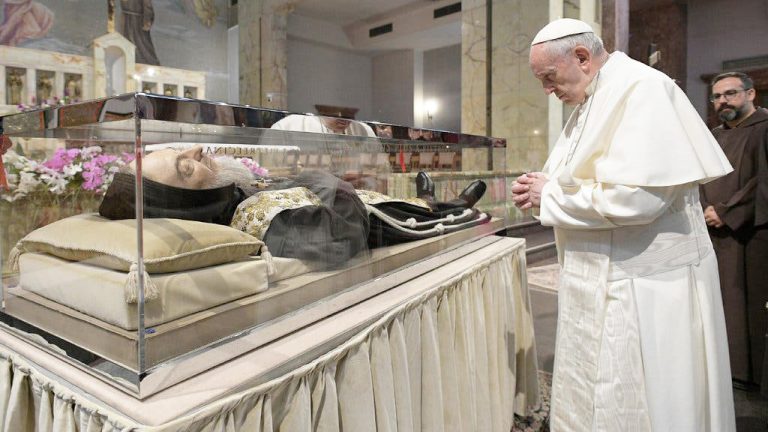Sorry, no records were found. Please adjust your search criteria and try again.
Sorry, unable to load the Maps API.
Four years on from her death at the age of 95, the Benedictine Sisters of Mary, Queen of the Apostles decided this week to relocate the mortal remains of their beloved founder, Sister Wilhelmina Lancaster, OSB.
Following a longstanding tradition for founders and foundresses, the nuns were anticipating a straightforward exhumation and reinterment of the skeletal remains of Sr Wilhelmina – but what they found has attracted global attention and led to hundreds of devout Catholic pilgrims descending on their small Benedictine monastery in rural Missouri.
Expecting to find just bones, the Benedictine Sisters instead unearthed a coffin with an apparently intact body, even though it had not been embalmed and the wooden coffin had a crack down the middle that had been letting in moisture and dirt for an unknown length of time during those four years. The body was covered in a layer of mould that had grown due to the high levels of condensation within the cracked coffin. Despite the dampness, little of Sr Wilhelmina’s body and nothing of her habit had disintegrated during the four years.
The shock was instant for the community who had gathered to exhume her.

“I thought I saw a completely full, intact foot and I said, ‘I didn’t just see that,’” said Mother Cecelia, OSB.
As the head of the monastery, it fell to her to examine what was in the coffin first.
“So I looked again more carefully,” she told Catholic News Agency. After she looked again, she screamed aloud, “I see her foot!” and the community, she said, “just cheered.”
“I mean there was just this sense that the Lord was doing this,” she said. “Right now we need hope. We need it. Our Lord knows that. And she was such a testament to hope. And faith. And trust.”
The news, and the subsequent pictures the sisters released showing the remains of Sr Wilhelmina, has attracted huge media attention, swamping social media channels and giving rise to a flood of conjecture and debate about the whole phenomenon of incorruptibility and the ethics of publicising such incidents. Such was the tumult and disinformation that the sisters felt obliged to issue a ‘fact sheet’ answering questions about the exhumation.
“Not only was her body in a remarkable preserved condition, her crown and bouquet of flowers were dried in place; the profession candle with the ribbon, her crucifix, and rosary were all intact,” the sisters declared.
“Even more remarkable was the complete preservation of her holy habit, made from natural fibers, for which she fought so vigorously throughout her religious life. They synthetic veil was perfectly intact, while the lining of the coffin, made of similar material, was completely deteriorated and gone.”
Abbess Cecilia stressed that the preservation of the habit is a large part of what she sees as miraculous, because the habit is “a beautiful sign that this life is not all there is.”
“People see us and it’s like ‘Oh, she’s a sister, oh she’s wearing that because she’s giving her life, she believes in God. Maybe I should think about God,’” she said, noting that the habit is “a sign of the things to come, of the supernatural and of our last end: heaven, hell, purgatory.”
“This is not possible,” she said of the incorruptible sister’s body. “God is real. He protected that body and that habit to enkindle our faith, to rekindle it, to bring people back to the faith.”
“You can’t Google ‘what do you do with an incorrupt body?’” Abbess Cecilia said, “so we started with the basics, just cleaning her with hot water because clinging to her face was basically a mask of thick mould.” For the time being, the sisters have crafted a wax mask for Sister Wilhelmina’s face and have also coated her hands with wax.
Born Mary Elizabeth Lancaster St. Louis, Missouri in 1924, Sister Wilhelmina felt drawn to become a nun from an early age, and on taking first vows, Mary Elizabeth took the name Wilhelmina in honour of her pastor.
After serving across the USA with the Oblate Sisters of Providence, Sister Wilhelmina left to found the Benedictines of Mary, Queen of the Apostles, in Scranton, Pennsylvania, where they dedicated five hours a day to chanting the Mass and Divine Offices, offering prayers specifically for priests and for vocations. In 2006, the order moved to Kansas City, establishing an abbey in 2010 in the unassuming countryside of rural Missouri, a peaceful location for a life of prayer and sacrifice – though the sisters are equally well known for their chart-topping Gregorian chant and classic Catholic hymn albums.
On May 29, 2019, at the vigil of the Ascension, with the rest of the community gathered around her singing Marian hymns, Sister Wilhemina said her last words, “O Maria,” and breathed her last. She was laid to rest in the abbey’s graveyard, and it was thus felt that the vigil of the Ascension this year was the day to perform the exhumation and relocation of her remains.
Whilst the many pilgrims descending on the monastery have said they believe they’re witnessing a miracle, we are still some way from declaring this to be the case. Indeed it will even be some time before Sister Wilhelmina can be declared an ‘incorruptible’.
For many centuries incorruptibility has been of fundamental importance and a source of the deepest reverence within the Catholic church – and the chapels and cathedrals of Europe are home to some 100 Incorruptibles, in various states of miraculous preservation and presentation.
Through the centuries the Catholic faithful have revered these bodies as sure signs of divine intervention and unquestionable proof of God’s presence in the life of these sacred individuals. More recently the Vatican has even brought science, pathology and forensic technologies to bear in the examination and evaluation of such remains, which has revealed that a wide range of human factors can contribute to significant bodily preservation – such as advances in embalming techniques, ground humidity and temperature, oxygen levels, and even the eating habits and lifestyles of the deceased.
It would be unfair to say that the Church has abandoned the notion of incorruptibility, but it certainly no longer accepts bodily preservation as one of the two miracles required to put the deceased on the road to sainthood. By definition a miracle is an event that cannot be explained by natural or scientific means, and an incorrupt corpse can present itself for many reasons that are not miraculous.
Today the tendency is to view an incorruptible corpse as a ‘passing sign’ from God rather than a permanent phenomenon, and it’s also important to note that for many of the famous incorrupt bodies what we are actually seeing are wax overlays on remains that have deteriorated over time.
To many outside the Catholic Church, and indeed to many within it, the reverence of the preserved bodies in this manner is an arcane and even odious preoccupation. Unlike relics – the bone or garment fragment of a saint – which are usually historic artefacts with no divine pretensions, the veneration of human corpses is for me at least a practice that now belongs far more to history than to the present. After all, if we truly believe that at the moment of death the soul has left the body and we’re just disposing of a shell, what exactly are we venerating, and by implication saying about the nature of divinity and human mortality?
As a father of two young sons this was really brought home to me in 2020 when the tomb of the Venerable Carlo Acutis was opened for public veneration ahead of the teen’s beatification. Whilst I can live reasonably comfortably with the withered remains of centuries old saints, the image of Carlo’s young body in his trainers and jump suit, his face (albeit a wax mask) looking as if he were just taking a brief nap, left me deeply unsettled. Even after decades as a journalist covering all manner of events it was a ‘sign’ I just couldn’t make myself comfortable with.

My consternation wasn’t helped by the spokeswoman for Carlo’s beatification who declared that while Carlo’s entire body is present, it isn’t ‘incorrupt’. At the Mass for the opening of the tomb, Archbishop Domenico Sorrentino of Assisi explained further.
“Today we … see [Carlo] again in his mortal body. A body that has passed, in the years of burial in Assisi, through the normal process of decay, which is the legacy of the human condition after sin has removed it from God, the source of life. But this mortal body is destined for resurrection,” Archbishop Domenico Sorrentino of Assisi said at a Mass at the opening of the tomb.
The bishop concluded by explaining that what were seeing was not an incorruptible but a body of a young boy that had been “reassembled with art and love.”
Quite what is going on here is beyond my humble Catholic understanding – I can only say if, God forbid, it was my son I would want to be celebrating his life (and especially in the case of Carlo Acutis), and not what had been left behind. But I’m sure there are plenty of other theologians and others out there who will take issue with me on this.
Back in Rural Missouri I do hope the Benedictine Sisters of Mary, Queen of the Apostles derive comfort and inspiration from the interest that the exhumation of their beloved Sr Wilhelmina has created, and that her brief reappearance serves as a reminder of God’s presence in the world to both the sisters and those who’ve been interested in this story.
There seems to be much excitement that their foundress might be the “first black African incorruptible” – whatever significance that has, and her orthodoxy and devotion to the Latin Mass has fired up another line of contentious adulation. But Sr Wilhelmina went to her eternal reward four years ago, and would likely be very profoundly unimpressed with all our worldly sadness, and our questionable preoccupation with preserving her mortal shell.
Joseph Kelly is a Catholic writer and theologian




































